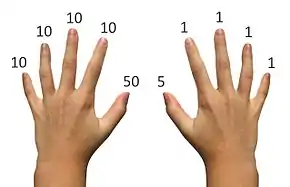
Chisanbop or chisenbop (from Korean chi (ji) finger + sanpŏp (sanbeop) calculation [1] 지산법/指算法), sometimes called Fingermath,[2] is a finger counting method used to perform basic mathematical operations. According to The Complete Book of Chisanbop[3] by Hang Young Pai, chisanbop was created in the 1940s in Korea by Sung Jin Pai and revised by his son Hang Young Pai, who brought the system to the United States in 1977.
With the chisanbop method it is possible to represent all numbers from 0 to 99 with the hands, rather than the usual 0 to 10, and to perform the addition, subtraction, multiplication and division of numbers.[4] The system has been described as being easier to use than a physical abacus for students with visual impairments.[5]
Basic concepts
.jpg.webp)
Each finger has a value of one, while the thumb has a value of five. Therefore each hand can represent the digits 0-9, rather than the usual 0-5.
The two hands combine to represent two digits; the right hand is the ones place, and the left hand is the tens place. This way, any number from 0 to 99 can be shown, and it's possible to count up to 99 instead of just 10.
The hands can be held above a table, with the fingers pressing down on the table; or the hands can simply be held up, fingers extended, as with the more common practice of 0-10 counting. [6]
Adoption in the United States
Chisanbop can be used for teaching math, or simply for counting. The results in education have been mixed. A school in Shawnee Mission, Kansas, ran a pilot program with students in 1979. It was found that although they could add large numbers quickly, they could not add them in their heads. The program was dropped. Grace Burton of the University of North Carolina said, "It doesn't teach the basic number facts, only to count faster. Adding and subtracting quickly are only a small part of mathematics."[7]
See also
References
- ↑ chisanbop. (n.d.). Dictionary.com Unabridged (v 1.1). Retrieved June 29, 2007, from Dictionary.com website: http://dictionary.reference.com/browse/chisanbop
- ↑ Lieberthal, Edwin M (1979). The Complete Book of Fingermath: Simple, Accurate,Scientific. London : Souvenir Press. ISBN 0285624385.
- ↑ Pai, Hang Young (1981). The Complete Book of Chisanbop: Original Finger Calculation Method Created by Sung Jin Pai and Hang Young Pai. Van Nostrand Reinhold. ISBN 0-442-27568-4.
- ↑ Casebeer, William D. (2001). Natural Ethical Facts: Evolution, Connectionism and Moral Cognition. University of California, San Diego. Retrieved 7 November 2019.
- ↑ "Education of the Visually Handicapped: The Official Publication of Association for Education of the Visually Handicapped". Education of the Visually Handicapped. Association for Education of the Visually Handicapped. 11–12. 1979. Retrieved 7 November 2019.
- ↑ Pai, Hang Young (1981). The Complete book of Chisanbop, 1981 (pages from 2 to 19) (PDF). Van Nostrand Reinhold. ISBN 0-442-27568-4.
- ↑ "What about Chisanbop -- who's using it?". Christian Science Monitor. 1982-05-17.
Further reading
- Lieberthal, Edwin M. (1979). The Complete Book of Fingermath. New York: McGraw-Hill. ISBN 0-07-037680-8.